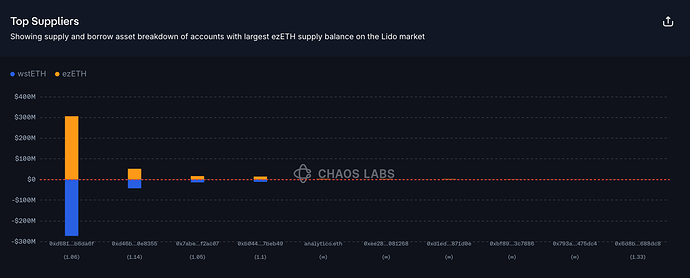Introduction
Chaos Labs’ monthly Renzo Risk Review delivers a comprehensive, data-driven analysis of Renzo’s key metrics, ensuring full transparency over protocol performance and risk exposure for the community. By closely monitoring utilization trends, liquidity dynamics, and yield outcomes, Chaos Labs aims to proactively identify and mitigate emerging risks to safeguard protocol stability.
Performance
Despite recent market volatility, ezETH maintained steady yield growth throughout February, realizing an APR of 3.48% over the month.
During the first market downturn in early February, ezETH traded at a maximum discount of 32.3bps to its exchange rate, which remained within the normal range observed during previous short-lived depegs over the past six months. By the second downturn in early March, the discount had narrowed further, indicating increasing resilience of ezETH’s peg against market volatility.
Throughout this period, the lowest deviation recorded was -32.34 bps , and the lowest was −4.45 bps. The shallow nature of the discounts, combined with their swift recovery, underscores the stability and reliability of ezETH even during volatile market conditions.
| Price Deviation in February (bps) | |
|---|---|
| Mean | -15.2 |
| Median | -15.2 |
| Highest | -3.2 |
| Lowest | -44.5 |
Supply trends indicate that the Renzo protocol continues to operate effectively, maintaining a substantial TVL of 319,515 ETH. Recent fluctuations in demand within the Renzo protocol align with broader market-wide deleveraging trends observed across the restaking sector. We will continue close monitoring of these developments to ensure timely and responsive strategy adjustments as market conditions evolve.
Liquidity
Over the past month, Renzo’s withdrawal buffer experienced a decrease from 7,200 ETH to approximately 4,900 ETH, while the stETH buffer increased from 16.4k to 20.3k. Currently, the standard cooldown period for withdrawals is three days.
Over the past 30 days, DEX liquidity data across multiple chains indicates adjustments in ezETH liquidity, particularly on Base and BNB chains, while exit liquidity remained relatively stable. Conversely, Optimism experienced increases in both ezETH and exit liquidity. Additionally, there was a notable increase in the use of wETH as exit liquidity during this period—a positive development for overall liquidity.
Composability
ezETH currently has 58% of its supply allocated to DeFi applications, with the majority held on Aave. Over February, ezETH supply on Aave increased notably from 103,000 to 173,000, and it now accounts for more than 55% of the circulating supply. Despite recent market volatility leading to heightened liquidation activity on Aave, no ezETH-related liquidations have occurred.
The minimal liquidation risk associated with ezETH is further supported by the fact that borrowing activities using ezETH as collateral on Aave are predominantly concentrated in wstETH positions. This underscores the resilience of the ezETH protocol under current market conditions.
However, it is worth highlighting that a substantial portion of ezETH supply on Aave is concentrated with a single depositor. The largest depositor, contributing around 320.8 million ETH, which accounts for approximately 77.71% of the total ezETH supply. Conversely, this depositor has borrowed roughly $273.16 million in wstETH, representing approximately 79.71% of total borrowings.
Summary
Despite recent market volatility, the Renzo protocol has shown notable resilience, maintaining a substantial TVL holdings and stable APR levels. ezETH experienced only minor and brief deviations from its peg. The overall liquidation risk remains low due to the stable nature of underlying borrowing asset. Nonetheless, continuous monitoring is recommended, especially in light of the concentration in ezETH supply and borrowing activities on Aave.








